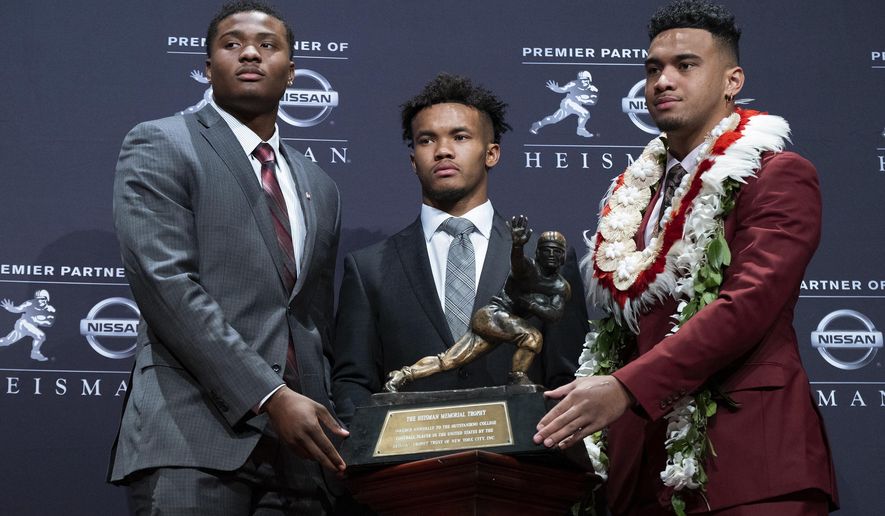ASHBURN — The career paths of Dwayne Haskins and Kyler Murray first intersected in high school. Murray, a native Texan, was a year ahead of Haskins, a Montgomery County product, but as two of the nation’s top prep quarterbacks, they shared texts and interacted on social media.
Then came college, where Murray beat out Haskins for the Heisman following an electric 2018 season. In the NFL draft a few months later, Murray went No. 1 overall, 14 picks ahead of Haskins.
Their paths cross again Sunday, when the two young signal-callers meet for the first time as pros when the Arizona Cardinals host Washington.
To get there, Haskins and Murray have each charted a different approach: Haskins is a prototypical pocket passer while Murray is an athletic dual-threat.
Most years in the NFL, analysts, scouts and front office types come to a consensus about which young quarterbacks are on the way to stardom. In the past, Patrick Mahomes and Lamar Jackson have been anointed. It’s early, but this season the smart money already seems to be settling on Murray — not Haskins.
Over the last decade, quarterbacks like Murray — undersized, but with legs as dangerous as his rocket arm — have become more and more valued.
Describing someone as a “mobile quarterback” once came off as a backhanded compliment, implying they could only run. In the era of Mahomes, Jackson and Russell Wilson, that’s no longer the case.
“He gives me anxiety,” Washington coach Ron Rivera said of Murray.
“The game has changed to a degree,” Cardinals coach Kliff Kingsbury said. “If you’re not a (Drew) Brees or (Tom) Brady getting the ball out on time, at the right place 100% of the time then you better have some athleticism to extend plays.”
Rivera knows what it’s like to work with a dynamic quarterback.
Over his nine years in Carolina, Rivera embraced Cam Newton’s style. Instead of trying to force him to be a pocket passer, the Panthers used Newton’s size and speed to their advantage. The 2015 MVP holds the most rushing yards out of any quarterback since entering the league in 2011 — and the 16th most out of all players.
Rivera said he’s noticed a shift in the way coaches have reacted to mobile quarterbacks. He noted that with the changing of rules — “You’re really not allowed to hit them like you used to be able to hit them,” Rivera said — coaches are more willing to use their quarterback as a running threat because “you can’t really crush them.”
He said the emergence of players like Murray and Mahomes has affected all other areas of the game: There are more zone-read concepts, more run-pass options (RPOs). Even offensive linemen have to be taught differently how to block, he said.
Kingsbury gave another reason for the swing: Coaches have less time to spend with players. There used to be “quarterback schools,” he said, and coaches would have all offseason to develop players. But the league’s collective bargaining agreement has cut down on practice time. “It’s just not there anymore,” he said.
Kingsbury, though, seems to have no problem with the league trending that way. With his signature air-raid offense, the second-year coach has designed his scheme to fit Murray’s strengths. Last year, Arizona ran the second-most RPOs in the league, according to Pro Football Reference. On those plays, Murray threw the ball 70 times and took off running 33 times.
Murray is an efficient passer, making him all the more dangerous. In last week’s win over the San Francisco 49ers, Murray completed 65% of his passes and threw for 230 yards and a touchdown.
“They have guys with speed that are running all over the field,” defensive coordinator Jack Del Rio said. “It looks like they have a joystick in a video game.”
By comparison, Haskins works best when he stands tall in the pocket, makes quick decisions and fires down field. Rivera has described Washington’s offense as a work in progress, reiterating again Thursday that the results may not come until next year. For the unit to reach that potential, Haskins will have to develop.
But a funny thing happened in Washington’s win over the Eagles: Among quarterbacks, Haskins ran the third-most RPOs in the league, according to Pro Football Reference.
Haskins is still a pocket passer, but offensive coordinator Scott Turner believes his quarterback has the mobility to keep defenses honest.
Haskins, too, has said he can run — and his offseason weight loss should make him faster in the open field.
That forces defenses to “respect everything,” Haskins said.
“With guys being able to throw the ball just as easy as they’re able to run it, it makes it easier for those dynamic athletes to play quarterback especially when they’re a quarterback first,” Haskins said. “I definitely like the ability to create and play within the pocket, so that’s kind of my game. But those guys who create just to make plays happen for their team, you’ve got to respect it.
“It’s fun to watch.”
• Matthew Paras can be reached at mparas@washingtontimes.com.




Please read our comment policy before commenting.